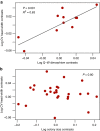Repeated evolution of soldier sub-castes suggests parasitism drives social complexity in stingless bees
- PMID: 28232746
- PMCID: PMC5431902
- DOI: 10.1038/s41467-016-0012-y
Repeated evolution of soldier sub-castes suggests parasitism drives social complexity in stingless bees
Abstract
The differentiation of workers into morphological castes represents an important evolutionary innovation that is thought to improve division of labor in insect societies. Given the potential benefits of task-related worker differentiation, it is puzzling that physical worker castes, such as soldiers, are extremely rare in social bees and absent in wasps. Following the recent discovery of soldiers in a stingless bee, we studied the occurrence of worker differentiation in 28 stingless bee species from Brazil and found that several species have specialized soldiers for colony defence. Our results reveal that worker differentiation evolved repeatedly during the last ~ 25 million years and coincided with the emergence of parasitic robber bees, a major threat to many stingless bee species. Furthermore, our data suggest that these robbers are a driving force behind the evolution of worker differentiation as targets of robber bees are four times more likely to have nest guards of increased size than non-targets. These findings reveal unexpected diversity in the social organization of stingless bees.Although common in ants and termites, worker differentiation into physical castes is rare in social bees and unknown in wasps. Here, Grüter and colleagues find a guard caste in ten species of stingless bees and show that the evolution of the guard caste is associated with parasitization by robber bees.
Figures


Similar articles
-
Enemy recognition is linked to soldier size in a polymorphic stingless bee.Biol Lett. 2017 Oct;13(10):20170511. doi: 10.1098/rsbl.2017.0511. Biol Lett. 2017. PMID: 28978757 Free PMC article.
-
A morphologically specialized soldier caste improves colony defense in a neotropical eusocial bee.Proc Natl Acad Sci U S A. 2012 Jan 24;109(4):1182-6. doi: 10.1073/pnas.1113398109. Epub 2012 Jan 9. Proc Natl Acad Sci U S A. 2012. PMID: 22232688 Free PMC article.
-
Soldiers in a Stingless Bee.Am Nat. 2016 Jan;187(1):120-9. doi: 10.1086/684192. Epub 2015 Nov 20. Am Nat. 2016. PMID: 27277408
-
Mechanisms and adaptations that shape division of labour in stingless bees.Curr Opin Insect Sci. 2023 Aug;58:101057. doi: 10.1016/j.cois.2023.101057. Epub 2023 May 24. Curr Opin Insect Sci. 2023. PMID: 37230412 Review.
-
The soldiers in societies: defense, regulation, and evolution.Int J Biol Sci. 2014 Mar 5;10(3):296-308. doi: 10.7150/ijbs.6847. eCollection 2014. Int J Biol Sci. 2014. PMID: 24644427 Free PMC article. Review.
Cited by
-
Extended haplodiploidy hypothesis.Evol Lett. 2019 Apr 29;3(3):263-270. doi: 10.1002/evl3.119. eCollection 2019 Jun. Evol Lett. 2019. PMID: 31171982 Free PMC article.
-
Enemy recognition is linked to soldier size in a polymorphic stingless bee.Biol Lett. 2017 Oct;13(10):20170511. doi: 10.1098/rsbl.2017.0511. Biol Lett. 2017. PMID: 28978757 Free PMC article.
-
Octopamine increases individual and collective foraging in a neotropical stingless bee.Biol Lett. 2020 Jun;16(6):20200238. doi: 10.1098/rsbl.2020.0238. Epub 2020 Jun 10. Biol Lett. 2020. PMID: 32516562 Free PMC article.
-
Resource adaptation drives the size-complexity rule in termites.Proc Biol Sci. 2024 Jan 10;291(2014):20232363. doi: 10.1098/rspb.2023.2363. Epub 2024 Jan 10. Proc Biol Sci. 2024. PMID: 38196360 Free PMC article.
-
Temporal Response of Foragers and Guards of Two Stingless Bee Species to Cephalic Compounds of the Robber Bee Lestrimelitta niitkib (Ayala) (Hymenoptera, Apidae).Neotrop Entomol. 2018 Dec;47(6):791-797. doi: 10.1007/s13744-018-0599-2. Epub 2018 Mar 16. Neotrop Entomol. 2018. PMID: 29549546
References
-
- Maynard-Smith, J. & Szathmáry, E. The Major Transitions in Evolution (Oxford University Press, 1997).
-
- Bourke, A. F. Principles of Social Evolution (Oxford University Press Oxford, 2011).
-
- Oster, G. F. & Wilson, E. O. Caste and Ecology in the Social Insects (Princeton University Press, 1978). - PubMed
Publication types
MeSH terms
LinkOut - more resources
Full Text Sources
Other Literature Sources

